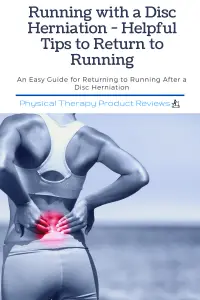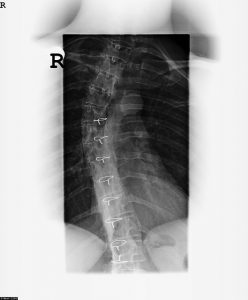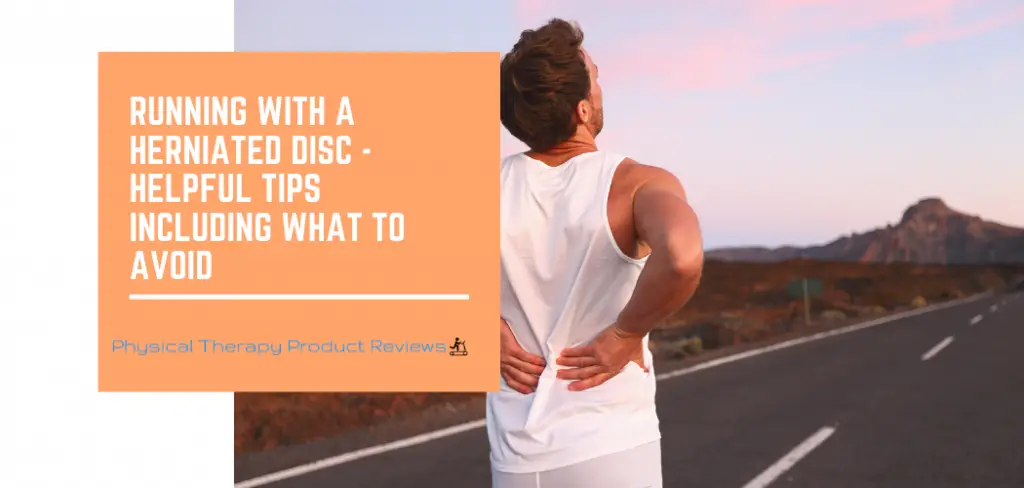There’s a lot that can interfere with your running routine: appointments, work, and family time, just to name a few. But few things interrupt a workout routine like pain and injury!
 Back pain is one of the most common ailments among athletes, affecting up to 40%. One common cause of back pain is a herniated disc. This injury can also lead to secondary symptoms of radiating pain to the hip or leg. Naturally, these are issues that can put a major block in your running streak.
Back pain is one of the most common ailments among athletes, affecting up to 40%. One common cause of back pain is a herniated disc. This injury can also lead to secondary symptoms of radiating pain to the hip or leg. Naturally, these are issues that can put a major block in your running streak.
A herniated disc, while painful, is not the end of your running routine. While you may be thinking otherwise, you do not need to give up running due to back pain. What you do need is an intentional and methodical plan to mend your injury and return to exercise.
Disc Herniation - The Healing Process
A herniated disc injury is typically caused by motions of flexion and rotation, be it in a single incident or as repetitive stress over time. It is usually precipitated by the weakness of stabilizing muscles of the back and hips in addition to poor form and posture.

This is a common injury found in many patients with and without back pain. Up to 76% of people with herniated discs identified on imaging have no symptoms of sciatica at all.
That means many many people are running with disc herniations right this minute and have no idea!
This informs us that the mere presence of a herniated disc does not identify dysfunction. Instead, a patient’s presenting symptoms and weaknesses should be the leading force in addressing their rehabilitation.
What to Expect
Depending on your injury and symptoms, you can expect to be able to return to your previous level of activity within 3-5 months.
The healing process of the spinal discs is slow. Some structures don’t have the best blood flow and need extra time to repair. For this reason, it’s important to be gradual with your recovery, so as not to stress the healing tissues. Bottom line: be patient.
Consulting a Physical Therapist
This guide will provide you with recommendations that you can manage on your own. It’s also advised that you seek consultation with a physical therapist to discuss a broader recovery program and the inclusion of treatments such as core strengthening, muscle re-education, and manual therapy.
When Can You Return to Running After a Herniated Disc
The best answer is to wait at least 6 weeks after the injury but for most, it’s 12 weeks or longer before returning to full running. It’s important to be patient to avoid causing flare-ups or a worse injury.
This depends on each person’s individual including how severe the herniation, the health of the patient, and how diligent they are with improving their overall strength and fitness.
How to Know You’re Ready to Return to Running
 There are few key factors to look for before trying to return to running. These include:
There are few key factors to look for before trying to return to running. These include:
- No symptoms down the leg during daily activities
- No pain with coughing and sneezing
- You can walk for 60 minutes without worsening symptoms
- You can perform 20 mini single leg squats on each leg without an increase in symptoms
At this point, you can begin a slow and gradual return to running. Start by jogging for 60 seconds and walking for 3-5 minutes. Slowly increase your time jogging and decrease your time running each week until you are able to jog the full time.
Expected Timeline for Return to Running After a Disc Injury
| Time Since the Injury | What to Do | Goals |
|---|---|---|
| 0- 3 Weeks | Walking, Stretching, Mobility drills, ice/heat and modalties | Be able to sleep, walk, and sit with minimal pain |
| 3 - 6 Weeks | Start strengthening, core work, resistance drills in the hips, core, and back | Squat, lunge, and hip hinge with minimal pain. Equal single-leg squat strength |
| > 6 Weeks | Gradual return to running. run 1:3 walk ratio at first | Progress running time, intensity, and distance at 10-15% per week |
Helpful Tips for Running with A Disc Herniation
The below tips will help steer your path to rehabbing from a herniated disc. Bear in mind that the full potential of your recovery will be dependent upon your dedication and persistence!
Strengthen your stabilizers:
Include exercises such as pushup and plank progressions, back bridges, resisted squats and deadlifts, monster walk (resisted side-stepping).

Start with simple and stable exercises, then progress into increasing weight, resistance, and balance challenging work.
Introduce a strengthening routine, to complete 3x/week. Exercises like weighted lunges, lat pulldowns, single-leg deadlifts, Turkish get-ups, and so on.
Stay Limber:
Include exercises such as prone press-ups, hip flexor stretch, hamstring stretch, lateral side stretching, Piriformis stretch (figure 4 stretch), spinal rotation.
Start incorporating nerve flossing in your flexibility routine. This exercise can improve the mobility of your nerves and help decrease radiating pain and numbness into the leg. Progress through the levels below as your symptoms can tolerate.
- Level 1: Lay flat on your back with your feet on the mat. Gently pull one knee towards your chest, then release it back down. Repeat.
- Level 2: Lay flat on your back with your feet on the mat. Hold one leg with hands behind the thigh. Slowly straighten your knee until you feel increased tension, then slowly lower back down. Repeat.
- Level 3: Lay flat on your back with your legs outstretched. Hold one leg with hands behind the thigh. Slowly straighten your leg up towards the ceiling, then flex your toes towards your body. You should feel increased tension down the leg and perhaps increased back soreness. Slowly bend the knee back to the starting position and repeat.
Use a foam roller to address tight areas like the glutes, low back, calves, and IT band.
Flexibility work should be completed daily, especially after exercise.

Hydrate! The nucleus of intervertebral discs is composed of 70-90% water. When disc height is decreased following a run, it’s indicative of a loss of disc hydration. Replenish those fluids in your body to supply necessary rehydration to your spine.
Fix Your Form:
Lifting: Even if you’re just bending over to pick up your water bottle – your form has got to be good. Keep your back straight and maintain the natural curve of your low back as you bend your knees and hips into a squat position.
Sitting: posture, posture, posture! Ensure your spine is in a neutral position while sitting – i.e. no slumping forward. Use a small lumbar pillow as a bolster in your low back and keep your hips positioned at the back of the chair.
Running: The act of running transmits three times the amount of force to your spine compared to walking. The purpose of the intervertebral discs of the spine is to resist compressive forces. A correlation has been found between long-distance running and loss of disc height following exercise.
Aim to keep your running stride shorter, with a higher cadence, to avoid a high-impact heel strike. That initial contact with the ground should have your foot landing just about directly under your hip.
Adjust your exercise schedule to include low-impact activities in place of daily running. Think cycling, swimming, and water running.
What to Avoid
Retraining your body to maintain a proper posture is key. Avoid regressing to poor positions, like slumped sitting.
It’s advised to avoid participating in impact activity daily, especially if symptoms are increasing. As recommended above, mix up your exercise routine with low-impact activities to give your body a break.
Do not “push through the pain” or try to ignore your injury. If your symptoms are on the rise, it means you need to pause and recalculate your exercise approach.
How to Run After a Herniated Disc
Don't Let Back Pain Stop You
A herniated disc is not a running disqualifier! You can safely return to exercise by minding your symptoms and progressing through a smart rehabilitation program. The human body is capable of great healing, you just need to give it the time to do so.
Works Referenced:
Beierle R, Burton P, Smith H, Smith M, Ives SJ. The effect of barefoot running on EMG activity in the gastrocnemius and tibia lies anterior in active college-aged females. International Journal of Exercise Science. 2019; 12(1): 1110-1120. https://www.ncbi.nlm.nih.gov/pmc/articles/PMC6886612/
Delitto A et al. Low back pain: clinical practice guidelines. Journal of Orthopaedic & Sports Physical Therapy. 2012; 42(4): A1-A57. https://www.jospt.org/doi/full/10.2519/jospt.2012.42.4.A1 .
Dydyk AM, Massa RN, Merfin FB. Disc herniation. Stat Pearls. 2020. https://www.ncbi.nlm.nih.gov/books/NBK441822/
Jacobs WC, et al. Surgery versus conservative management of sciatica due to a lumbar herniated disc: a systematic review. European Spine Journal. 2011; 20: 512-522. https://link.springer.com/article/10.1007/s00586-010-1603-7
Petering RC, Webb C. Treatment options for low back pain in athletes. Sports Health. 2011; 3(6): 550-555. https://www.ncbi.nlm.nih.gov/pmc/articles/PMC3445234/
VanGelder LH, Hoogenboom BJ, Vaughn DW. A phased rehabilitation protocol for athletes with lumbar intervertebral disc herniation. International Journal of Sports Physical Therapy. 2013; 8(4): 482-516. https://www.ncbi.nlm.nih.gov/pmc/articles/PMC3812831/
White TL, Malone TR. Effects of running on intervertebral disc height. Journal of Orthopaedic & Sports Physical Therapy. 1990; 12(4): 139-146. https://www.jospt.org/doi/pdf/10.2519/jospt.1990.12.4.139
Other Great Rehab Related Articles
How to Stay Active After Cervical Fractures: Expert Tips and Advice
Dealing with Painful Stairs After Ankle Replacement Surgery
Walking After a Total Ankle Replacement: Tips for a Successful Recovery
Exercises While Non-Weight Bearing After Ankle Replacement: Elevation, AROM, Leg Raises, and More
Ankle Pain with Stairs: Causes and Home Treatment Options
5 Common Mistakes You’re Making After an Ankle Sprain
Disclaimer: The information provided in this post is for educational purposes only. This is not a substitute for a medical appointment. Please refer to your physician before starting any exercise program.






